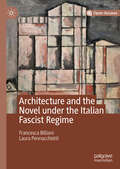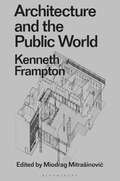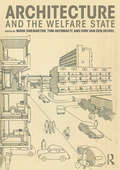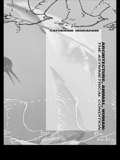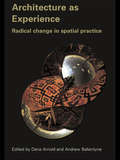- Table View
- List View
Architecture and the Novel under the Italian Fascist Regime
by Francesca Billiani Laura PennacchiettiArchitecture and the Novel under the Italian Fascist Regime discusses the relationship between the novel and architecture during the Fascist period in Italy (1922-1943). By looking at two profoundly diverse aesthetic phenomena within the context of the creation of a Fascist State art, Billiani and Pennacchietti argue that an effort of construction, or reconstruction, was the main driving force behind both projects: the advocated “revolution” of the novel form (realism) and that of architecture (rationalism). The book is divided into seven chapters, which in turn analyze the interconnections between the novel and architecture in theory and in practice. The first six chapters cover debates on State art, on the novel and on architecture, as well as their historical development and their unfolding in key journals of the period. The last chapter offers a detailed analysis of some important novels and buildings, which have in practice realized some of the key principles articulated in the theoretical disputes.
Architecture and the Paradox of Dissidence
by Ines WeizmanArchitecture and the Paradox of Dissidence maps out and expands upon the methodologies of architectural action and reinvigorates the concept of dissent within the architectural field. It expands the notion of dissidence to other similar practices and strategies of resistance, in a variety of historical and geographical contexts.The book also discusses how the gestures and techniques of past struggles, as well as ‘dilemmas’ of working in politically suppressive regimes, can help to inform those of today. This collection of essays from expert scholars demonstrates the multiple responses to this subject, the potential and dangers of dissidence, and thus constructs a robust lexicon of concepts that will point to possible ways forward for politically and theoretically committed architects and practitioners.
Architecture and the Paradox of Dissidence
by Ines WeizmanArchitecture and the Paradox of Dissidence maps out and expands upon the methodologies of architectural action and reinvigorates the concept of dissent within the architectural field. It expands the notion of dissidence to other similar practices and strategies of resistance, in a variety of historical and geographical contexts.The book also discusses how the gestures and techniques of past struggles, as well as ‘dilemmas’ of working in politically suppressive regimes, can help to inform those of today. This collection of essays from expert scholars demonstrates the multiple responses to this subject, the potential and dangers of dissidence, and thus constructs a robust lexicon of concepts that will point to possible ways forward for politically and theoretically committed architects and practitioners.
Architecture and the Politics of Gender in Early Modern Europe (Women and Gender in the Early Modern World)
by Helen HillsWritten by leading scholars in the field, the essays in this book address the relationships between gender and the built environment, specifically architecture, in early modern Europe. In recent years scholars have begun to investigate the ways in which architecture plays a part in the construction of gendered identities. So far the debates have focused on the built environment of the nineteenth and twentieth centuries to the neglect of the early modern period. This book focuses on early modern Europe, a period decisive for our understanding of gender and sexuality. Much excellent scholarship has enhanced our understanding of gender division in early modern Europe, but often this scholarship considers gender in isolation from other vital factors, especially social class. Central to the concerns of this book, therefore, is a consideration of the intersections of gender with social rank. Architecture and the Politics of Gender in Early Modern Europe makes a major contribution to the developing analysis of how architecture contributes to the shaping of social relations, especially in relation to gender, in early modern Europe.
Architecture and the Politics of Gender in Early Modern Europe (Women and Gender in the Early Modern World)
by Helen HillsWritten by leading scholars in the field, the essays in this book address the relationships between gender and the built environment, specifically architecture, in early modern Europe. In recent years scholars have begun to investigate the ways in which architecture plays a part in the construction of gendered identities. So far the debates have focused on the built environment of the nineteenth and twentieth centuries to the neglect of the early modern period. This book focuses on early modern Europe, a period decisive for our understanding of gender and sexuality. Much excellent scholarship has enhanced our understanding of gender division in early modern Europe, but often this scholarship considers gender in isolation from other vital factors, especially social class. Central to the concerns of this book, therefore, is a consideration of the intersections of gender with social rank. Architecture and the Politics of Gender in Early Modern Europe makes a major contribution to the developing analysis of how architecture contributes to the shaping of social relations, especially in relation to gender, in early modern Europe.
Architecture and the Public World: Kenneth Frampton (Radical Thinkers in Design)
by Kenneth FramptonArchitecture and the Public World brings together key writings by Kenneth Frampton, the eminent architectural historian and critic, from the 1980s to the present. Articles are grouped into thematic sections representing abiding concerns of Frampton's criticism: history and critical theory; modes of criticism; the vicissitudes of urban form, and tactility, tectonics, and resistance. The volume also includes a new interview with Frampton and an essay by Clive Dilnot exploring the relevance of Frampton's thought for design history and criticism.The anthology represents Frampton's abiding concern for labor and the political dimensions of architecture, including his development of the concept of 'critical regionalism', but, in featuring writings from across the range and breadth of Frampton's career, enables a broader understanding of his work, demonstrating the potential for architectural interpretation and analysis to function as a mode of cultural criticism.
Architecture and the Public World: Kenneth Frampton (Radical Thinkers in Design)
by Kenneth FramptonArchitecture and the Public World brings together key writings by Kenneth Frampton, the eminent architectural historian and critic, from the 1980s to the present. Articles are grouped into thematic sections representing abiding concerns of Frampton's criticism: history and critical theory; modes of criticism; the vicissitudes of urban form, and tactility, tectonics, and resistance. The volume also includes a new interview with Frampton and an essay by Clive Dilnot exploring the relevance of Frampton's thought for design history and criticism.The anthology represents Frampton's abiding concern for labor and the political dimensions of architecture, including his development of the concept of 'critical regionalism', but, in featuring writings from across the range and breadth of Frampton's career, enables a broader understanding of his work, demonstrating the potential for architectural interpretation and analysis to function as a mode of cultural criticism.
Architecture and the Smart City
by Sergio M. Figueiredo Sukanya Krishnamurthy Torsten SchroederIncreasingly the world around us is becoming ‘smart.’ From smart meters to smart production, from smart surfaces to smart grids, from smart phones to smart citizens. ‘Smart’ has become the catch-all term to indicate the advent of a charged technological shift that has been propelled by the promise of safer, more convenient and more efficient forms of living. Most architects, designers, planners and politicians seem to agree that the smart transition of cities and buildings is in full swing and inevitable. However, beyond comfort, safety and efficiency, how can ‘smart design and technologies’ assist to address current and future challenges of architecture and urbanism? Architecture and the Smart City provides an architectural perspective on the emergence of the smart city and offers a wide collection of resources for developing a better understanding of how smart architecture, smart cities and smart systems in the built environment are discussed, designed and materialized. It brings together a range of international thinkers and practitioners to discuss smart systems through four thematic sections: ‘Histories and Futures’, ‘Agency and Control’, ‘Materialities and Spaces’ and ‘Networks and Nodes’. Combined, these four thematic sections provide different perspectives into some of the most pressing issues with smart systems in the built environment. The book tackles questions related to the future of architecture and urbanism, lessons learned from global case studies and challenges related to interdisciplinary research, and critically examines what the future of buildings and cities will look like.
Architecture and the Smart City
by Sergio M. Figueiredo Sukanya Krishnamurthy Torsten SchroederIncreasingly the world around us is becoming ‘smart.’ From smart meters to smart production, from smart surfaces to smart grids, from smart phones to smart citizens. ‘Smart’ has become the catch-all term to indicate the advent of a charged technological shift that has been propelled by the promise of safer, more convenient and more efficient forms of living. Most architects, designers, planners and politicians seem to agree that the smart transition of cities and buildings is in full swing and inevitable. However, beyond comfort, safety and efficiency, how can ‘smart design and technologies’ assist to address current and future challenges of architecture and urbanism? Architecture and the Smart City provides an architectural perspective on the emergence of the smart city and offers a wide collection of resources for developing a better understanding of how smart architecture, smart cities and smart systems in the built environment are discussed, designed and materialized. It brings together a range of international thinkers and practitioners to discuss smart systems through four thematic sections: ‘Histories and Futures’, ‘Agency and Control’, ‘Materialities and Spaces’ and ‘Networks and Nodes’. Combined, these four thematic sections provide different perspectives into some of the most pressing issues with smart systems in the built environment. The book tackles questions related to the future of architecture and urbanism, lessons learned from global case studies and challenges related to interdisciplinary research, and critically examines what the future of buildings and cities will look like.
Architecture and the Turkish City: An Urban History of Istanbul since the Ottomans (Library of Modern Turkey)
by Murat GülArchitecture and urban planning have always been used by political regimes to stamp their ideologies upon cities, and this is especially the case in the modern Turkish Republic. By exploring Istanbul's modern architectural and urban history, Murat Gül highlights the dynamics of political and social change in Turkey from the late-Ottoman period until today. Looking beyond pure architectural styles or the physical manifestations of Istanbul's cultural landscape, he offers critical insight into how Turkish attempts to modernise have affected both the city and its population. Charting the diverse forces evident in Istanbul's urban fabric, the book examines late Ottoman reforms, the Turkish Republic's turn westward for inspiration, Cold War alliances and the AK Party's reaffirmation of cultural ties with the Middle East and the Balkans. Telltale signs of these moments – revivalist architecture drawing on Ottoman and Seljuk styles, 1930s Art Deco, post-war International Style buildings and the proliferation of shopping malls, luxurious gated residences and high-rise towers, for example – are analysed and illustrated in extensive detail. Connecting this rich history to present-day Istanbul, whose urban development is characterised anew by intense social stratification, the book will appeal to researchers of Turkey, its architecture and urban planning.
Architecture and the Welfare State
by Mark Swenarton Tom Avermaete Dirk van den HeuvelIn the decades following World War Two, and in part in response to the Cold War, governments across Western Europe set out ambitious programmes for social welfare and the redistribution of wealth that aimed to improve the everyday lives of their citizens. Many of these welfare state programmes - housing, schools, new towns, cultural and leisure centres – involved not just construction but a new approach to architectural design, in which the welfare objectives of these state-funded programmes were delineated and debated. The impact on architects and architectural design was profound and far-reaching, with welfare state projects moving centre-stage in architectural discourse not just in Europe but worldwide. This is the first book to explore the architecture of the welfare state in Western Europe from an international perspective. With chapters covering Austria, Belgium, France, Germany, Italy, The Netherlands, Sweden and the UK, the book explores the complex role played by architecture in the formation and development of the welfare state in both theory and practice. Themes include: the role of the built environment in the welfare state as a political project the colonial dimension of European welfare state architecture and its ‘export’ to Africa and Asia the role of welfare state projects in promoting consumer culture and economic growth the picture of the collective produced by welfare state architecture the role of architectural innovation in the welfare state the role of the architect, as opposed to construction companies and others, in determining what was built the relationship between architectural and social theory the role of internal institutional critique and the counterculture. Contributors include: Tom Avermaete, Eve Blau, Nicholas Bullock, Miles Glendinning, Janina Gosseye, Hilde Heynen, Caroline Maniaque-Benton, Helena Mattsson, Luca Molinari, Simon Pepper, Michelle Provoost, Lukasz Stanek, Mark Swenarton, Florian Urban and Dirk van den Heuvel.
Architecture and the Welfare State
by Mark Swenarton Tom Avermaete Dirk van den HeuvelIn the decades following World War Two, and in part in response to the Cold War, governments across Western Europe set out ambitious programmes for social welfare and the redistribution of wealth that aimed to improve the everyday lives of their citizens. Many of these welfare state programmes - housing, schools, new towns, cultural and leisure centres – involved not just construction but a new approach to architectural design, in which the welfare objectives of these state-funded programmes were delineated and debated. The impact on architects and architectural design was profound and far-reaching, with welfare state projects moving centre-stage in architectural discourse not just in Europe but worldwide. This is the first book to explore the architecture of the welfare state in Western Europe from an international perspective. With chapters covering Austria, Belgium, France, Germany, Italy, The Netherlands, Sweden and the UK, the book explores the complex role played by architecture in the formation and development of the welfare state in both theory and practice. Themes include: the role of the built environment in the welfare state as a political project the colonial dimension of European welfare state architecture and its ‘export’ to Africa and Asia the role of welfare state projects in promoting consumer culture and economic growth the picture of the collective produced by welfare state architecture the role of architectural innovation in the welfare state the role of the architect, as opposed to construction companies and others, in determining what was built the relationship between architectural and social theory the role of internal institutional critique and the counterculture. Contributors include: Tom Avermaete, Eve Blau, Nicholas Bullock, Miles Glendinning, Janina Gosseye, Hilde Heynen, Caroline Maniaque-Benton, Helena Mattsson, Luca Molinari, Simon Pepper, Michelle Provoost, Lukasz Stanek, Mark Swenarton, Florian Urban and Dirk van den Heuvel.
Architecture And Truth In Fin-de-siècle Vienna (PDF)
by Leslie ToppThis 2004 book examines one of the key notions of modernist architecture as it was formulated in Vienna at the turn of the twentieth century. Providing a close analysis of four major buildings - Olbrich's Secession Building, Hoffmann's Purkersdorf Sanatorium, Wagner's Postal Savings Bank, and Loos's Michaelerplatz building - Leslie Topp investigates how 'truth' could be interpreted in a variety of ways, including truth to purpose, symbolist or ideal truth, and ethical notions of authenticity. Drawing on newly uncovered archival materials, Topp offers an interpretation of familiar buildings that are shown to encompass utopianism, hyper-rationality, and subjectivism. She also explores the connections between Viennese modern architecture and contemporary painting, psychiatry, fashion, labor issues, and anti-Semitic politics.
Architecture and Ugliness: Anti-Aesthetics and the Ugly in Postmodern Architecture
by Wouter Van Acker Thomas MicalWhatever 'ugliness' is, it remains a problematic category in architectural aesthetics - alternately vilified and appropriated, either to shock or to invert conventions of architecture.This book presents eighteen new essays which rethink ugliness in architecture - from brutalism to eclectic postmodern architectural productions - and together offer a diverse reappraisal of the history and theory of postmodern architecture and design. The essays address both broad theoretical questions on ugliness and postmodern aesthetics, as well as more specific analyses of significant architectural examples dating from the last decades of the twentieth century, addressing the relation between the aesthetic register of ugliness and aesthetic concepts such as brutalism, kitsch, the formless, ad hoc-ism, the monstrous, or the grotesque.The aim of this volume is not simply to document the history of a postmodern anti-aesthetic through case studies. Instead, it aims to shed light on an aesthetic problem that has been largely overlooked in the agenda of architectural theory, the question if and how ugliness can be of interest to architecture; or if and how architecture can make good use of ugliness.
Architecture and Ugliness: Anti-Aesthetics and the Ugly in Postmodern Architecture
by Wouter Van Acker Thomas MicalWhatever 'ugliness' is, it remains a problematic category in architectural aesthetics - alternately vilified and appropriated, either to shock or to invert conventions of architecture.This book presents eighteen new essays which rethink ugliness in architecture - from brutalism to eclectic postmodern architectural productions - and together offer a diverse reappraisal of the history and theory of postmodern architecture and design. The essays address both broad theoretical questions on ugliness and postmodern aesthetics, as well as more specific analyses of significant architectural examples dating from the last decades of the twentieth century, addressing the relation between the aesthetic register of ugliness and aesthetic concepts such as brutalism, kitsch, the formless, ad hoc-ism, the monstrous, or the grotesque.The aim of this volume is not simply to document the history of a postmodern anti-aesthetic through case studies. Instead, it aims to shed light on an aesthetic problem that has been largely overlooked in the agenda of architectural theory, the question if and how ugliness can be of interest to architecture; or if and how architecture can make good use of ugliness.
Architecture and Urban Transformation of Historical Markets: Cases from the Middle East and North Africa (Architecture and Urbanism in the Global South)
by Neveen HamzaThis book explores the complex relationship between societies, architecture, and urbanism of market halls, traditional souqs, bazaars, and speciality street markets in the Middle East and North Africa. It addresses how these trading environments influence perceptions of place and play an extended social, political, and religious role while adapting to their local climates. Through Archival research and social science methodologies, this book records and maps markets in urban fabrics, expanding on practices underlying the push towards historical listings and the development of markets as landmarks in the urban fabric. The role of markets in delivering sustainable place-making strategies and influencing the development of cities’ socio-economic and historical strength is addressed as key to their survival in the urban fabric and as place-making landmarks for preserving tangible and intangible heritage. Going beyond heritage and conservation studies, this book discusses how positioning and restoring markets challenges urban renewal policies, access to public space planning, environmental sustainability, security of food supply, cultural heritage, and tourism. This is an ideal read for those interested in the history of urban development, architecture and urban planning, and architectural heritage.
Architecture and Urban Transformation of Historical Markets: Cases from the Middle East and North Africa (Architecture and Urbanism in the Global South)
by Neveen HamzaThis book explores the complex relationship between societies, architecture, and urbanism of market halls, traditional souqs, bazaars, and speciality street markets in the Middle East and North Africa. It addresses how these trading environments influence perceptions of place and play an extended social, political, and religious role while adapting to their local climates. Through Archival research and social science methodologies, this book records and maps markets in urban fabrics, expanding on practices underlying the push towards historical listings and the development of markets as landmarks in the urban fabric. The role of markets in delivering sustainable place-making strategies and influencing the development of cities’ socio-economic and historical strength is addressed as key to their survival in the urban fabric and as place-making landmarks for preserving tangible and intangible heritage. Going beyond heritage and conservation studies, this book discusses how positioning and restoring markets challenges urban renewal policies, access to public space planning, environmental sustainability, security of food supply, cultural heritage, and tourism. This is an ideal read for those interested in the history of urban development, architecture and urban planning, and architectural heritage.
Architecture and Urbanism in a Contact Zone: Histories of Difference, Migrancy and Dwelling in Kolkata (Architecture and Urbanism in the Global South)
by Mark Mukherjee CampbellThis book explores how histories of migration, cultural encounter and transculturation have shaped formations of urban space, domestic architecture and cultural modernity in Kolkata from the early colonial period to the beginning of the era of India’s economic liberalization. It charts how these themes were manifest in what was an important ‘contact zone’ in the history of globalization and the modern city. Drawing on a wide range of resources and representations, from urban plans and architectural drawings to European travel journals and Bengali literature and cinema, the book investigates the history of Kolkata through an examination of key urban and architectural spaces across the colonial and postcolonial epochs. Through illustrated chapters, it sheds new light on questions of difference and segregation, cultural hybridity, migration, and entanglements of tradition and modernity in the city, analyzing spaces inhabited by a diverse range of cultures, including several neglected in previous studies. Architecture and Urbanism in a Contact Zone offers an instructive contribution to the fields of global architectural history and theory, urban studies and postcolonial cultural studies for scholars, researchers and students alike.
Architecture and Urbanism in a Contact Zone: Histories of Difference, Migrancy and Dwelling in Kolkata (Architecture and Urbanism in the Global South)
by Mark Mukherjee CampbellThis book explores how histories of migration, cultural encounter and transculturation have shaped formations of urban space, domestic architecture and cultural modernity in Kolkata from the early colonial period to the beginning of the era of India’s economic liberalization. It charts how these themes were manifest in what was an important ‘contact zone’ in the history of globalization and the modern city. Drawing on a wide range of resources and representations, from urban plans and architectural drawings to European travel journals and Bengali literature and cinema, the book investigates the history of Kolkata through an examination of key urban and architectural spaces across the colonial and postcolonial epochs. Through illustrated chapters, it sheds new light on questions of difference and segregation, cultural hybridity, migration, and entanglements of tradition and modernity in the city, analyzing spaces inhabited by a diverse range of cultures, including several neglected in previous studies. Architecture and Urbanism in a Contact Zone offers an instructive contribution to the fields of global architectural history and theory, urban studies and postcolonial cultural studies for scholars, researchers and students alike.
Architecture and Urbanism in the British Empire (Oxford History of the British Empire Companion Series)
by G. A. BremnerThroughout today's postcolonial world, buildings, monuments, parks, streets, avenues, entire cities even, remain as witness to Britain's once impressive if troubled imperial past. These structures are a conspicuous and near inescapable reminder of that past, and therefore, the built heritage of Britain's former colonial empire is a fundamental part of how we negotiate our postcolonial identities, often lying at the heart of social tension and debate over how that identity is best represented. This volume provides an overview of the architectural and urban transformations that took place across the British Empire between the seventeenth and mid-twentieth centuries. Although much research has been carried out on architecture and urban planning in Britain's empire in recent decades, no single, comprehensive reference source exists. The essays compiled here remedy this deficiency. With its extensive chronological and regional coverage by leading scholars in the field, this volume will quickly become a seminal text for those who study, teach, and research the relationship between empire and the built environment in the British context. It provides an up-to-date account of past and current historiographical approaches toward the study of British imperial and colonial architecture and urbanism, and will prove equally useful to those who study architecture and urbanism in other European imperial and transnational contexts. The volume is divided in two main sections. The first section deals with overarching thematic issues, including building typologies, major genres and periods of activity, networks of expertise and the transmission of ideas, the intersection between planning and politics, as well as the architectural impact of empire on Britain itself. The second section builds on the first by discussing these themes in relation to specific geographical regions, teasing out the variations and continuities observable in context, both practical and theoretical.
Architecture and Urbanism in Viceregal Mexico: Puebla de los Ángeles, Sixteenth to Eighteenth Centuries (Routledge Research in Architectural History)
by Juan Luis BurkeArchitecture and Urbanism in Viceregal Mexico presents a fascinating survey of urban history between the sixteenth and eighteenth centuries. It chronicles the creation and development of Puebla de los Ángeles, a city located in central-south Mexico, during its viceregal period. Founded in 1531, the city was established as a Spanish settlement surrounded by important Indigenous towns. This situation prompted a colonial city that developed along Spanish colonial guidelines but became influenced by the native communities that settled in it, creating one of the most architecturally rich cities in colonial Spanish America, from the Renaissance to the Baroque periods. This book covers the city's historical background, investigating its civic and religious institutions as represented in selected architectural landmarks. Throughout the narrative, Burke weaves together sociological, anthropological, and historical analysis to discuss the city’s architectural and urban development.Written for academics, students, and researchers interested in architectural history, Latin American studies, and the Spanish American viceregal period, it will make an important contribution to the field.
Architecture and Urbanism in Viceregal Mexico: Puebla de los Ángeles, Sixteenth to Eighteenth Centuries (Routledge Research in Architectural History)
by Juan Luis BurkeArchitecture and Urbanism in Viceregal Mexico presents a fascinating survey of urban history between the sixteenth and eighteenth centuries. It chronicles the creation and development of Puebla de los Ángeles, a city located in central-south Mexico, during its viceregal period. Founded in 1531, the city was established as a Spanish settlement surrounded by important Indigenous towns. This situation prompted a colonial city that developed along Spanish colonial guidelines but became influenced by the native communities that settled in it, creating one of the most architecturally rich cities in colonial Spanish America, from the Renaissance to the Baroque periods. This book covers the city's historical background, investigating its civic and religious institutions as represented in selected architectural landmarks. Throughout the narrative, Burke weaves together sociological, anthropological, and historical analysis to discuss the city’s architectural and urban development.Written for academics, students, and researchers interested in architectural history, Latin American studies, and the Spanish American viceregal period, it will make an important contribution to the field.
Architecture, Animal, Human: The Asymmetrical Condition
by Catherine T. IngrahamThis book looks at specific instances in the Renaissance, Enlightenment and our own time when architectural ideas and ideas of biological life come into close proximity with each other. These convergences are fascinating and complex, offering new insights into architecture and its role. Establishing architecture as a product of the ascendancy of the position of human life, the author shows here that while architecture is dependent on life forces for its existence, at the same time it must be, at some level, indifferent to the life within it. Life, for its part, privileges itself above all else, and seeks to continuously expand its field of expression. This, then, is the asymmetrical condition, and to understand it is to gain important new theoretical perspectives into the nature of architecture.
Architecture, Animal, Human: The Asymmetrical Condition
by Catherine T. IngrahamThis book looks at specific instances in the Renaissance, Enlightenment and our own time when architectural ideas and ideas of biological life come into close proximity with each other. These convergences are fascinating and complex, offering new insights into architecture and its role. Establishing architecture as a product of the ascendancy of the position of human life, the author shows here that while architecture is dependent on life forces for its existence, at the same time it must be, at some level, indifferent to the life within it. Life, for its part, privileges itself above all else, and seeks to continuously expand its field of expression. This, then, is the asymmetrical condition, and to understand it is to gain important new theoretical perspectives into the nature of architecture.
Architecture as Experience: Radical Change in Spatial Practice
by Dana Arnold Andrew BallantyneArchitecture as Experience investigates the perception and appropriation of places across intervals of time and culture. The particular concern of the volume is to bring together fresh empirical research and animate it through contact with theoretical sophistication, without overwhelming the material. The chapters establish the continuity of a particular physical object and show it in at least two alternative historical perspectives, in which recognisable features are shown in different lights. The results are often surprising, inverting the common idea of a historic place as having an enduring meaning. This book shows the insight that can be gained from learning about earlier constructions of meaning which have been derived from the same buildings that stand before us today.
